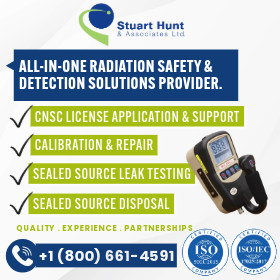CIPR 2019 : Les mines, la médecine et la planète Mars
A report from the 5th International Symposium on the System of Radiological Protection in Adelaide, Australia
In November 2019, ICRP held its 5th International Symposium on the System of Radiological Protection in Adelaide, Australia. The theme for the symposium was Mines, Medicine, and Mars.
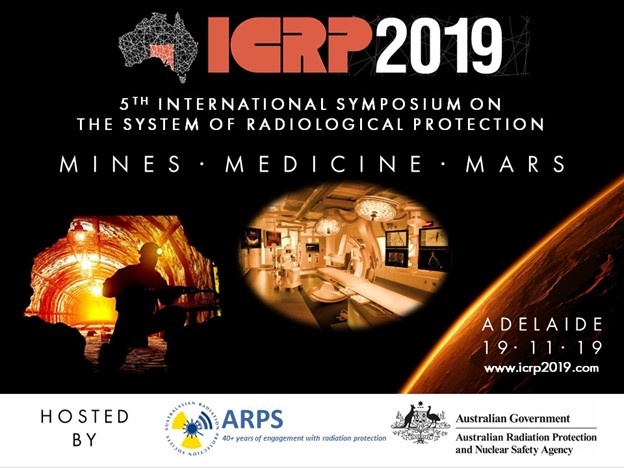
The symposium, with over 400 attendees representing 33 countries, was well attended. There were over 65 oral presentations and approximately 80 poster presentations. There was also a well-attended sponsor area that featured a mix of commercial vendors, association representatives, academics, radiation protection–related agencies, and government. Notable Canadian booths included the Radiation Safety Institute of Canada and representatives for the 2021 ICRP Symposium, to be held in Vancouver, BC, and co-hosted by ICRP, the Canadian Nuclear Safety Commission (CNSC), and CRPA.
Highlights of the event included the entertaining and well-received lecture by the Bo Lindell Medal recipient, Dr. Elizabeth Ainsbury: Interdisciplinary Dosimetry Research Supporting Medical (and Wider) Uses of Ionizing Radiation. She summarized research done by the Health Protection Research Unit for Chemical and Radiation Threats and Hazards, including projects under the health effects of medical radiation exposure research domain:
- Determining the risks to the exposed population in the context of other health risks.
- Determining variability in clinical response in relation to biomarkers and measures of exposure in patients undergoing radio-therapeutic procedures.
- Using in vitro approaches to identify variability in cellular responses and novel biomarkers of exposure.
A major outcome of this research will be evidence base and advice for safely using medical diagnostic procedures for specific patient groups. Another outcome will be accurate markers of exposure to radiation.
Each day of the symposium had a dedicated theme: mines, medicine, and Mars. (Radiation protection in medicine had a dedicated day, but talks on this subject were also sprinkled throughout all three days.) There were many excellent presentations, and a few are highlighted below.
Exploring the association between radiation and lens of eye cataracts was a highlight of the medical presentations. Dr. Christopher Thome (Laurentian University) presented early data from an observational study of over 16 million Ontarians and the association between head CT scan and cataracts. While gender (i.e., being female) and age (i.e., progressive risk after the age of 50) were associated with cataracts, the number of head CT scans was not. This work, which has recently been published,[1] adds to the evolution of our understanding of radiation-induced cataractogenesis.
I presented results from a dosimetry survey of lens of eye dose in occupational nuclear medicine settings conducted in Winnipeg and published in Health Physics.[2] In our study, the annualized dose ranges were 0.0 mSv to 3.68 mSv (lens of eye) and 0.48 mSv to 4.72 mSv (whole body). The findings should be generalizable to other, similar work settings, especially in North America, and should be sufficient to demonstrate regulatory compliance with the proposed new lens of eye dose limits in nuclear medicine settings.
Many talks explored methods of detecting/quantifying and monitoring radon, especially in the mining industry. For example, there was a very interesting talk by the Australian Radiation Protection and Nuclear Safety Agency on radon exposure in caves. Cave radon levels varied by season and more discreetly by meteorological conditions. In their survey it was not uncommon to find radon levels above 1,000 Bq/m3.
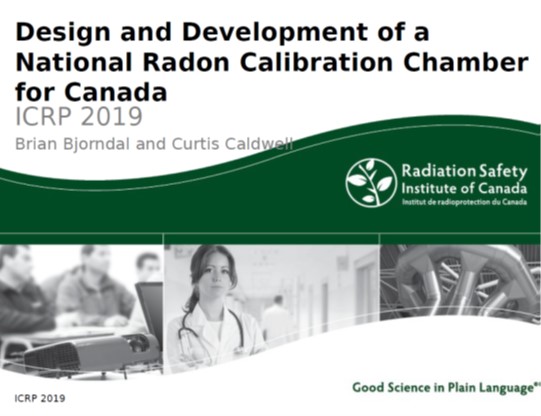
Brian Bjorndal and Curtis Caldwell from the Radiation Safety Institute of Canada gave a talk on the history and evolution of their radon chamber. They also discussed the Coalition of International Radon Associations (COIRA) and collaborative work related to harmonizing international reference atmospheres of primary and tertiary radon chambers.
Mars, or “space,” was a highlight of the symposium. The key lectures in this area were by Leena Tomi from the Canadian Space Agency and former Canadian astronaut Dr. Robert Thirsk.

When contemplating missions to Mars, radiation protection considerations are not trivial. For example, and based on the as low as reasonably possible (ALARA) principle, NASA has suggested an annual dose limit of 500 mSv and a career dose limit of 1 Sv to 4 Sv for astronauts.[3] This is comparable to the American Nuclear Regulatory Commission (NRC) annual occupational dose limit of 50 mSv and CNSC’s dose limit of 20 mSv (averaged over five years with a maximum of 50 mSv in any one year).
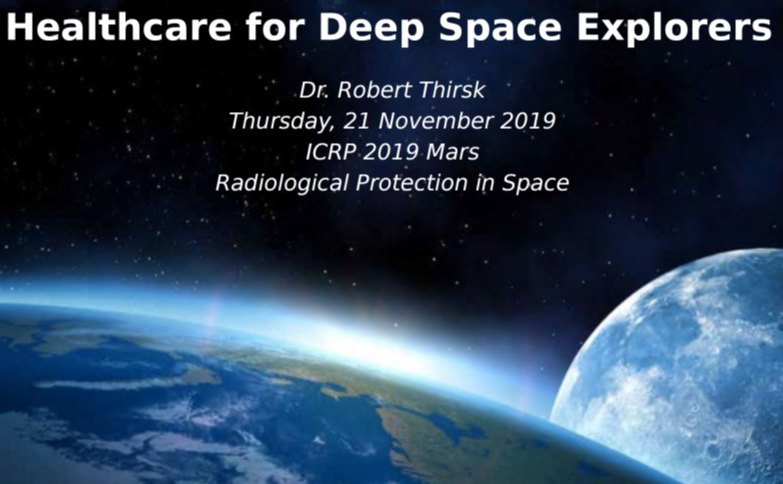
Dr. Thirsk gave an engaging talk highlighting a full spectrum of health considerations for extended space missions and innovative measures of addressing such. The proposed use of 3D printers to make various medical and other device components seemed very innovative.
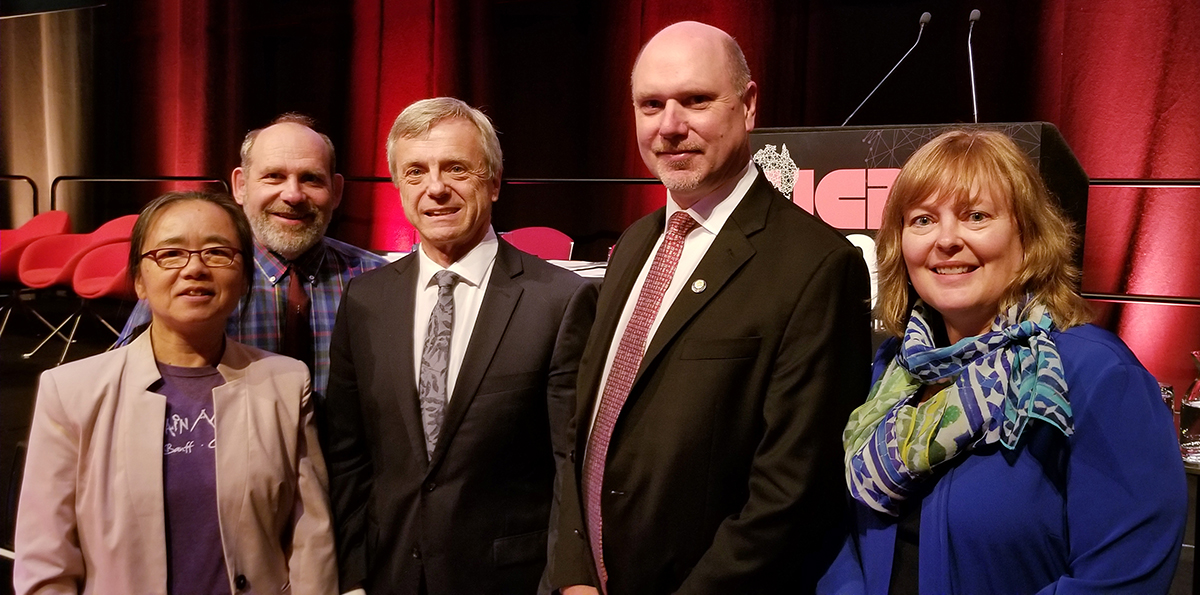
Canadian representatives meeting with former Canadian astronaut Robert Thirsk. From left to right: Jing Chen (Health Canada), Sandor Demeter (IRCP Committee 3), Dr. Robert Thirsk (former Canadian astronaut), Mike Rinker (CNSC), Caroline Purvis (CNSC).
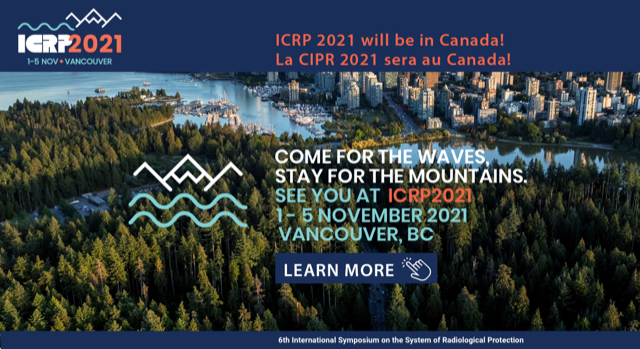
ICRP 2021
November 1–4, 2021
Vancouver, BC
ICRP, CNSC, and CRPA are looking forward to welcoming you to ICRP 2021 in beautiful Vancouver, BC. With the breathtaking views from the Westin Bayshore in downtown Vancouver, the hosts are excited to provide another world-class program.
CRPA members at the conference will also have an opportunity to attend CRPA’s 2021 annual general meeting. (Watch for details!)
Notes:
[1] Cataract Formation and Low-Dose Radiation Exposure from Head Computed Tomography (CT) Scans in Ontario, Canada, 1994–2015
[2] Demonstrating Compliance with Proposed Reduced Lens of Eye Dose Limits in Nuclear Medicine Settings
[3] NASA, Space Faring: The Radiation Challenge radiation education guide
Résumé : CIPR 2019 : Les mines, la médecine et la planète Mars
Rapport du 5e Symposium international sur la radioprotection à Adelaïde, en Australie.
En novembre 2019, la CIPR tenait son 5e Symposium international sur la radioprotection à Adelaïde, en Australie qui avait pour thème Les mines, la médecine et la planète Mars. Cette activité au taux de participation élevé a attiré 400 participants de 33 pays, accueilli plus de 65 conférences et présenté environ 80 affiches. Dans son rapport, Sandor Demeter partage quelques points forts de l’activité et rappelle aux lecteurs que le prochain symposium aura lieu au Canada!
 Dr. Sandor Demeter
Dr. Sandor Demeter
Dr. Sandor Demeter is a nuclear medicine physician in Winnipeg, MB. He is also a commission member of the Canadian Nuclear Safety Commission (CNSC), a member of the International Commission on Radiological Protection (ICRP) Committee 3 (medicine), and a member of the Canadian Agency for Drugs and Technologies in Health (CADTH) Health Technology Expert Review Panel.
Dr Sandor Demeter est médecin en physique nucléaire à Winnipeg, au Manitoba. Il est également membre de la Commission canadienne de sûreté nucléaire (CCSN), de la Commission internationale de protection radiologique (CIPR) Comité 3 (médecine) et du panel de révision expert des technologies de la santé de l’Agence canadienne des médicaments et des technologies de la santé (ACMTS).
Do you want to read more articles like this?
The Bulletin is published by the Canadian Radiation Protection Association (CRPA). It’s a must-read publication for radiation protection professionals in Canada. The editorial content delivers the insights, information, advice, and valuable solutions that radiation protection professionals need to stay at the forefront of their profession.
Sign up today and we’ll send you an email each time a new edition goes live. In between issues, check back often for updates and new articles.
Don’t miss an issue. Subscribe now!
Subscribe

 Dr. Sandor Demeter
Dr. Sandor Demeter
